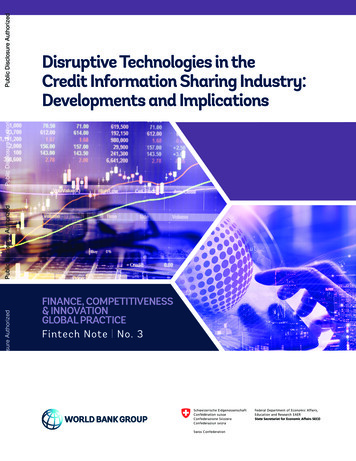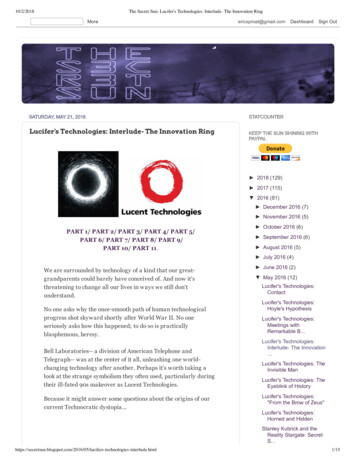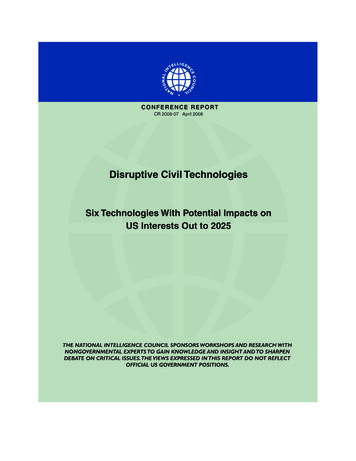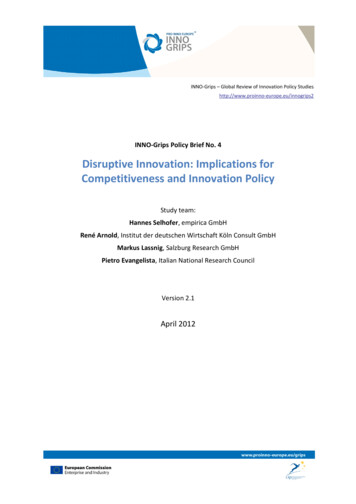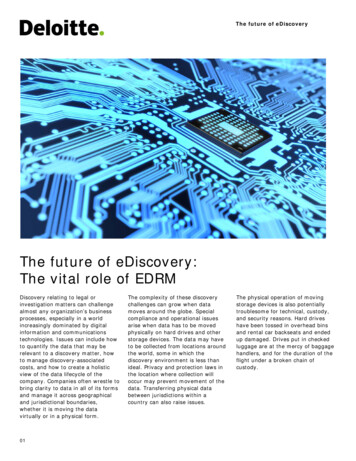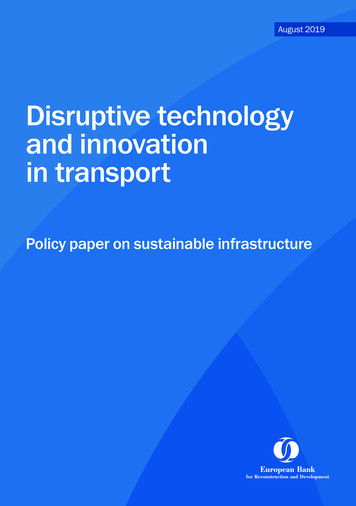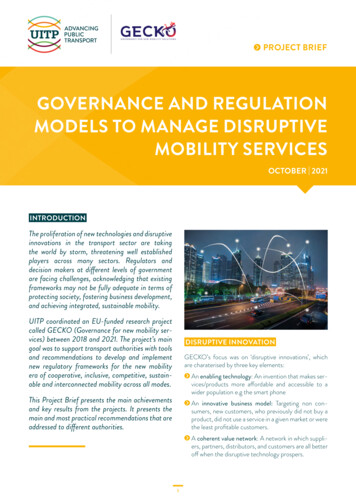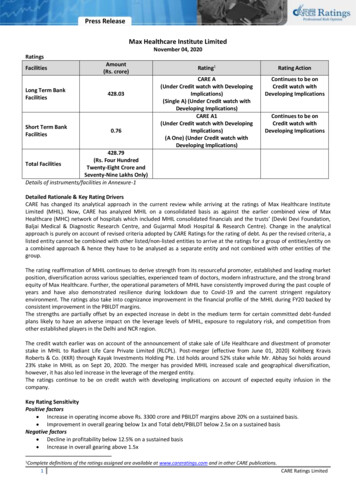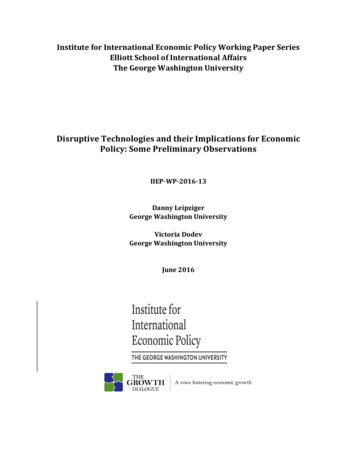
Transcription
Institute for International Economic Policy Working Paper SeriesElliott School of International AffairsThe George Washington UniversityDisruptive Technologies and their Implications for EconomicPolicy: Some Preliminary ObservationsIIEP-WP-2016-13Danny LeipzigerGeorge Washington UniversityVictoria DodevGeorge Washington UniversityJune 2016
DISRUPTIVE TECHNOLOGIES AND THEIR IMPLICATIONS FOR ECONOMICPOLICY: SOME PRELIMINARY OBSERVATIONSD. LEIPZIGER AND V. DODEV*I. IntroductionIt is generally accepted that technological innovation has been at the core of firm levelproductivity gains and the economic growth of countries. This general proposition as describedby Solow (1956) and enhanced by Romer (1990), Aghion and Howitt (1992), and others embedsin it the notion that more productive firms will displace less productive ones in a Schumpeterianfashion. The exponential rise in economic growth since the second industrial revolution and themassive increase in living standards serve as a historical testament to the importance oftechnological innovation. We have seen technology’s important role in the catch up of emergingmarket economies (EMEs) with advanced economies, notably in the case of the high-growth EastAsian economies (Leipziger, 1993). This was largely done through learning and absorbingtechnologies from abroad, along with successful resource mobilization and the building up ofhuman and physical capital (Yusuf, 2012).*Danny Leipziger is a Professor of International Business and International Affairs, George WashingtonUniversity and Managing Director of the Growth Dialogue. Victoria Dodev is a recent graduate of theElliott School of International Affairs at George Washington University.1
As a catalyst for economic growth, technological progress provides much potentialupside, but it can also be a disruptive force for labor markets and established business models.Disruptive innovation, as coined by Clayton Christenson (The Innovator’s Dilemma), refers to aninnovation that creates a new market by applying a different set of values, and which ultimately(and unexpectedly) overtakes an existing market. It does this partly by harnessing newtechnologies, but also by developing new business models and exploiting old technologies innew ways. Products based on disruptive technologies are typically cheaper to produce, simpler,better performing, and more convenient to useDisruptive technologies have the potential to impact growth, employment, and inequalityby creating new markets and business practices, needs for new product infrastructure, anddifferent labor skills. This, in addition to affecting existing firms in established markets, can alsoaffect the labor market, incomes of workers, and ultimately the distribution of income. Examplesof disruptive technologies include email, the personal computer and laptop, and smartphones,which have revolutionized communication and the way that we work or spend leisure time, andhave displaced many products such as typewriters, mainframes, pocket cameras, and GPSdevices, among others. New business models are also disrupting entire industries, such as Uberwith taxi cabs, Netflix with satellite and cable television, and Skype with telecommunications.Disruptive technologies can certainly benefit the consumer by providing cheaper, moreaccessible goods or services. They will have potentially negative effects on firms, however.Indeed, Christenson argues that most firms are slow to anticipate or react to disruptive forces.Firms may therefore suffer declines in shareholder value and lose markets. The knock-on effecton labor markets is more unsettling as workers are often less well placed to retrain, retool, orrelocate, and traditional program of adjustment assistance have proven to be largely ineffective.2
This creates an issue for public policy as governments may be confronted with the effects ofdisruptive technologies in the form of displaced workers and increased demands for assistance.For these reasons, a closer look at disruptive technologies is warranted, especially duringtimes of both rapid technological change as well as shifts in the distribution of income that mayhurt the owners of labor rather than the owners of capital. In a way, this corresponds to theconcerns raised by Piketty (2014) and others that inequality is growing and that prevailingtrends may yet be re-enforced by technological change, part of which can be characterized asdisruptive innovation.The McKinsey Global Institute (MGI) has identified 12 areas which exhibit the greatesteconomic impact and potential to cause disruption by 2025: mobile Internet, automation ofknowledge work (artificial intelligence, AI), the Internet of Things, cloud technology, advancedrobotics, autonomous and near autonomous vehicles, next generation genomics, energy storage,3-D printing, advanced materials, advanced oil and gas explorations, and renewable energy(Manyika, et al., 2013) (Annex: Exhibit 1). These trends were chosen using four criteriaincluding high rate of technological change, broad potential scope of impact, large economicvalue affected, and potential for disruptive economic impact. Together they are estimated toaffect trillions of dollars of economic activity and tens of millions of workers. (See Annex:Exhibit 2 for a detailed example of 3D printing as a disruptive technology and its economiceffects.)These disruptive trends are ushering in a new era in which digital technologies aremeeting or surpassing the capabilities of humans, even in tasks which do not follow astraightforward application of existing rules and were impossible to automate before, such asthose involving communication or pattern recognition in uncertain or changing environments3
like the road. Moore’s law is often cited as a way of understanding increases in computingcapabilities, stating that processing power of computers doubles every two years. This meansthat there is both exponential growth in computing capability, and that computers of the sameprocessing power get cheaper quickly. The outcome of increasingly less expensive and morepowerful computers is affordable devices which are reaching human level performance.The potential positive impact on economic activity, and hence economic growth, is cleareven if magnitudes are at best guesses; however, the issue of impact on labor markets is far moreserious. Labor-saving technological change is nothing new, indeed the 1960s exhibited hugealarm-bells concerning automation, which in the end were exaggerated worries. One may gliblysay that it will take more than robots to build robots, but the pace of disruptive technologies thatcan influence manufacturing via robots and 3D printing is perhaps over-shadowed by theadvances in AI that have the potential of displacing workers in the service sectors at an evenmore rapid pace and with more significant consequences. This reflects the fact that a) mostadvanced economies are now dominated by service sector employment and that b) most new jobcreation in the advanced economies over the last few decades has been in the service sectors ofeconomic activity.Disruptive technologies have different implications for firms, employment, consumers,and nations. Consumers are arguably poised to benefit the most as new technologies allowcheaper, or free, and more sophisticated goods and services to emerge. The effects onemployment include some positives, such as increased efficiency and workplace flexibility, butthe negatives are possibly greater in magnitude. Large scale displacement of not only manual androutine, but cognitive and non-routine, labor will hollow out both middle and low incomeproduction and service jobs, and affect high skilled knowledge work as well. Labor will also find4
difficulty adjusting in terms of skills as jobs are redefined and new roles are created. There willbe an increased need for education and re-skilling, and the development of a comparative skillsadvantage to machines.Firms in general will benefit from labor costs savings through increased labor efficiencyand the transition of some tasks to computers and machines, and those which can capitalize ondisruptive trends by moving into new products and markets will be the most advantaged. Muchlike labor, however, some firms will be displaced as products and services become obsolete, free,or unprofitable. The firms which can adjust successfully will likely be those which are welldiversified and able to sustain the disruption of single industries, such as Siemens1, or companieswhich invest in disruptive trends, such as IBM, which has a renewed focus on areas such ascloud computing, mobile, analytics, and AI.Nations which will be able to cushion themselves best from the negative consequences ofdisruptive trends and facilitate adjustment are those which can handle the negative effects onemployment and increasing income inequality. These would include nations with high skilledand educated populations or access to high quality and affordable higher education; socialprograms and safety nets, such as unemployment assistance and reskilling; and those with higherdegrees of labor mobility. Labor market programs are largely identified with countries, such asSweden and Denmark, that have a proclivity for public sector interventions, the fiscal capacity todo so, and the political support for redistributive programs. This is seen most clearly in thedifferences between ex-ante and ex-post measures of inequality, namely, the Gini Coefficient1Siemens’ business areas include information and communication, automation and control, power,transportation, energy, healthcare, lighting, finance and real estate.5
(one measure of inequality of income) which shows huge changes due to government tax andredistributive policies in Scandinavia in particular (OECD, 2015).Labor market flexibility and labor’s physical mobility are other factors often associatedwith easier adjustments to shifts in labor demand. The U.S. has historically been seen as anexample of a country with flexible labor markets (viz., characterized perhaps by the phrase easyto hire and easy to fire) as compared to Western Europe especially. Moreover, labor’s mobilitywas always seen as a plus, although as seen in Figure 1, the mover rate in the U.S. has declinedsignificantly over the last twenty years, making adjustments in the labor market all the moredifficult. Whether this is due to dual-income earners or other factors is not clear, and one cannotexclude the possibility of amenities and politics in certain parts of the country being impediments(see Moretti, 2012 and others).6
II. The Growth StoryThe estimated economic effect of disruptive technologies is vast, in the tens of trillionsannually, and it is thought that these technologies have significant potential to drive globalgrowth by creating new markets and products (Manyika, et al., 2013). Historically, the bulk ofcross country differences in GDP per capita have been a result of cross country gaps in multifactor productivity (MFP) and, to a lesser extent, due to human capital. Over the past decade,closure of these gaps have accounted for much of GDP growth, and MFP will continue to be adriver of convergence in the future. Capital deepening has also contributed to growth, but withdecreasing returns to capital and a slowdown to capital accumulation, it is not likely to be a longterm growth driver in most countries (Johansson, et al, 2012). The same applies for labor, asdemographic shifts and aging populations, especially in advanced economies, have adversegrowth implications.A number of OECD countries have been experiencing a slowdown in labor productivitysince 2000, and in fact, data shows a broad-based decline in the contribution of labor (humancapital accumulation) to GDP growth across countries, a pattern which will continue into thefuture (OECD, 2015a) (Figure 2). There has also been a slowdown or flat-lining in thecontribution of capital deepening after 2000 in most OECD countries, a trend exacerbated after2007, along with declines in multi factor productivity, the contribution of which is now negativein many countries. It is important to note, however, that MFP is partially a result of investment inintangible, knowledge-based capital (KBC)2 and technology, which may not suffer from thesame decreasing returns to scale and can be a source of sustained long term growth. This2This includes R&D, firm specific skills, organizational know-how, databases, design and various formsof intellectual property.7
suggests that the slowdown in MFP may partly reflect the pull-back in the pace of KBCaccumulation in the early 2000s, showing that the diffusion of knowledge and technology, ascaptured in KBC accumulation, has a measured impact on global growth (OECD 2015a).8
The effect on economic growth of disruptive technologies cannot be fully accounted forin GDP figures, as much of the benefit is not captured in the market value of associated goodsand services. This includes the benefit of free products and information (Google, Skype,WhatsApp, Wikipedia) which replace paid products, entertainment value from social and digitalmedia, increased buying choices through online platforms, and reduced search and transactioncosts, among others (Brynjolfsson and McAfee, 2014).Some are not as optimistic. Robert Gordon, for example, argues that technology will notimprove economic performance in the long run, using the United States as an example, becauseof four headwinds: demographics, education, inequality, and government debt (2014). Theseheadwinds will reduce the GDP per capita growth rate from an average of 2% per year between1891-2007, to 0.9% for the period 2007 to 2032 as shown in Figure 3. Gordon contends thatthese headwinds have decreased potential long run GDP, not just actual short run GDP, and thatthe low growth of recent years will be sustained. He shows that the annual growth rate of TFPpeaked in the 1950s, and has been much lower than the mid-20th century since the 90s; thus,arguing technological progress likely will not overtake the headwinds and have a major positiveimpact on growth.9
There is little doubt that we need increasingly to be wary of the measurement errors ofboth productivity and GDP itself in a digital world in which many sources of information andmany means of communication entail almost zero-cost. Past attempts to deal with GDPinaccuracies (such as the Stiglitz-Sen Commission Report, 2009) noted failings, but we have yetto see much progress in altered measured of economic activity. On the side of technology,Aghion and co-authors (2016a) claim that we may be missing as much as 0.5 to 0.8 percent inGDP growth from a mis-measurement of new technologies by way of improved but unmeasuredquality gains. This fact, notwithstanding what governments will face increasingly, is changes inemployment, that may rightly or wrongly be attributed to globalization, trade, and off-shoring; orto new technologies and skills mis-matches; or to other factors (see Autor, 2013a, 2013b, 2013c,2015 for the case of the U.S. for some empirics). One thing is clear, and that is that it would be apublic policy mistake not to think ahead in terms of employment implications, even though thelandscape is uncertain.10
III. Effects on EmploymentDisappearing Jobs: A U.S. CaseIn recent years there has been much debate about jobless growth, and some have pointedto a decoupling effect as a consequence of advances in technology. As digital technologiesexpand and are able to handle a greater scope of routine work, machines are able to substituteless skilled and educated workers, putting downward pressure on the median wage (Brynjolfssonand McAfee, 2014). The phenomenon spreads as computers proliferate and get cheaper andemployers prefer hiring more capital to labor, affecting job volumes. As new advances inartificial intelligence allow computers to expand into work that is not just routine, such as somehigh skilled service sector jobs, this affect will only accelerated. As such, persistentunemployment in the modern world can become a structural issue, not just cyclical.We choose to look at the U.S. as a case study because of its high degree of technologicalinnovation and business opportunity. It is a global leader in new technology as measured by thenumber of patents, startups focused on disruptive trends, and gazelle firms, and it is home tonotable companies such as Apple, Google, Microsoft, Facebook, IBM, and Cisco. In the WorldEconomic Forum’s 2015 Global Competiveness Index, the U.S. is ranked 3rd out of 140countries, with notable leads in labor market efficiency (4th), business sophistication (4th),innovation (4th), and market size (2nd), and it is ranked 17th in technological readiness. The U.S.is also ranked 6th overall out of 50 countries in Bloomberg’s 2015 Innovation Index, whichfactors in R&D (11th), Manufacturing (10th), Hi-Tech Companies (1st), Education (33rd),Research Personnel (19th), and Patents (4th).11
Technological business development is also supported by low barriers to entry andavailability of credit. The U.S. is ranked second among OECD nations in openness of productmarket regulation, which includes state ownership, barriers to entrepreneurship, and barriers totrade and investment3. It is also ranked 7th out of 189 economies in the 2016 Ease of DoingBusiness Index, with a notable lead access to credit at 2nd. Businesses are able to take advantageof a high depth of angel finance and venture capital, as the U.S. has the most venture capitalinvestments of any economy, absolutely and as a percentage of GDP (OECD, 2015b).The U.S. is also a good laboratory for evaluating the positive and negative effects ofdisruptive technology when we take into account employment trends in manufacturing and thedistribution of jobs which has occurred as a result of innovation. Manufacturing employment hasdropped from around 18 million in 1980 to around 12 million in 2014, as total privateemployment has expanded by about 50 million jobs in that period (Figure 4). Of the 27.3 millionjobs which were added between 1990 and 2008, 97.7% stemmed from the non-tradable servicessector, notably in government and health care (Spence and Hlatshwayo, 2012). Tradable servicesalso experienced job growth in high end services such as management and consulting, computersystem design, finance, and insurance, which were roughly matched by declines in mostmanufacturing areas.3OECD 2008 Product Market Regulation Indicators. The indicators were revised in 2013 but data on theUnited States was not included. Breaking down the three categories, the U.S. ranks 2nd in state control, 2ndin barriers to entrepreneurship, and 21st in barriers to trade and investment.12
While some of this erosion of manufacturing jobs is due to a shortage in the supply ofskilled labor, offshoring and globalization of production chains, trade penetration, and someshifts in tax policy, technology is also a contributing factor (Autor, 2015). Traditionally,manufacturing and routine jobs have been the most susceptible to technological advancement.The U.S. has exhibited increasing labor market polarization with a structural shift towards lowincome service and manual work, as middle income manufacturing jobs get hollowed out, andtowards high income cognitive jobs, where skilled labor has a comparative advantage overcomputers in terms of problem solving abilities. In 1979, the four “middle skilled” job categories(sales; office and administrative workers; production workers; and operatives) accounted for 60percent of employment. In 2007, this number was 49 percent, and in 2012, it was 46 percent(Autor, 2015)(Figure 5). It is reasonable therefore to expect computerization to continue toimpact service and non-routine work.13
A major structural phenomenon, seen in Figure 6, is that jobs and wages have becomedecoupled from productivity and GDP growth. The post-war trend, the “ good old days”, wherejobs, productivity, and incomes grew in unison, stopped in the late 1980s. Employment andincome have been growing at a much slower rate than either productivity or GDP since, and haveeven fallen some in the last decade. The effects have been seen in two main waves; in the first,spanning from the early 1990s to the early 2000s, in “ the new world,” the effect was mainlyseen in declining incomes. Since the early 2000s, as computers and digital technologies becameubiquitous in the workplace, employment has also completely decoupled from output andproductivity. This stark trend is shown as the “ brand new world “ in Fig. 6. This decrease inemployment and the resulting decline in median income has also had the effect of increasing14
income inequality (Stiglitz 2012). This trend will be exacerbated with the hollowing out ofmiddle income jobs in the age of new disruptive technologies. In the future, more wealth will goto those who make or control technology; either those already owning capital or newentrepreneurs4.Figure 6Brand NewWorldGood Old DaysNew WorldDecliningIncomeDecliningEmploymentSource: Census Bureau, Bureau of Labor Statistics, Brynolfsson and McAfeeThe Future Outlook in the U.S.Looking forward, Frey and Osborne evaluate the effects of new technologies onemployment by estimating the probability of computerization for 702 occupations and find that47 percent of total U.S. employment is at high risk in a decade or two, where risk is defined as aprobability of computerization of 70% or above (2013). While most automatable tasks in the pastwere routine, AI, through algorithms, will have a widespread effect on computerization of non4One phenomenon associated with disruptive technology is the “winner takes all” aspect in which marketdominance and rents are captured by selected new entrants (Brynolfsson and McAfee, 2014)15
routine, cognitive tasks, such as fraud detection or healthcare diagnostics, or work in legal andfinancial services. MGI suggests that AI can be responsible for the replacement of 140 millionknowledge workers globally by 2025 (Manyika, et al., 2013). In the near to medium term, certainactivities and not whole occupations are at risk for automation. According to MGI, as many as45% of the activities individuals are paid to perform can be automated by adapting currentlydemonstrated technologies, representing about 2 trillion in wages within the United States,which compares to about 7 trillion of total wages in 2014. When AI reaches human levelprocessing capabilities, an additional 13% of work activities in the U.S. economy could beautomated (Chui, 2015). Thus, even some of the highest paid jobs such as executives, financialmanagers, and physicians have many tasks which are susceptible to automation.In terms of non-routine manual tasks, more advanced robotics, such as those that canclimb wind turbines or perform surgical procedures, are a direct threat to jobs as robots developgreater flexibility and range of motion (Frey and Osborne, 2013). With improved sensors, robotsare becoming increasingly capable of producing goods of higher quality and with greaterreliability than humans, and will become a more attractive substitutes as costs decrease overtime. Big data, sophisticated sensors, and the Internet of Things also merge with AI to affect thelogistics and transportation industry through autonomous vehicles.Looking at the top 10 industries in the United States, as measured by their share of totalemployment, which account for about 74% of jobs in 2014, some of the top employmentindustries are also the most susceptible to computerization (Figure 7). These include office andadministrative support, production, food preparation/service, construction/extraction, sales andtransportation/moving, among others. Three industries which have notably low probabilities:education/training/library, healthcare practitioners/technical healthcare roles, and management.16
These industries require a high degree of originality, persuasion, and social perceptiveness and/ormanual dexterity, specifically in healthcare. It is important to note that these industries also tendto have higher median wages than the others, further evidencing the thesis that low and middleincome jobs will be eroded.Global TrendsGlobal trends are difficult to predict and therefore estimates are equally difficult to assesswithout a degree of skepticism. That said, the World Economic Forum (WEF) recentlyestimated that there will be a net employment impact of more than 5.1 million jobs lost todisruptive labor market changes over the period 2015–2020, with a total loss of 7.1 million jobsand a total gain of 2 million jobs worldwide (WEF 2016). These estimates are based on a survey17
of the largest employers representing more than 13 million employees across 9 broad industrysectors in 15 major developed and emerging economies and regional economic areas. The largestimpact was reported as losses in office and administrative, and manufacturing and production,accompanied by some gains in several smaller job families such as management, computer andmathematical, and business and financial operations (Figure 8). Thus growth in employment is,according to the WEF, expected to be generated from smaller, generally high-skilled job familiesthat will likely be dwarfed by job losses; moreover, the newly created jobs will requiresignificantly different skills which put a challenge on existing education systems (seeTrajtenberg, 2016).18
These trends will be exacerbated by the increase in global unemployment due to globalpopulation growth and slow job creation over the period 2015-2019. In many advancedeconomies of Europe, North America, and Japan, demographic trends such as aging populationswill lead to continued labor force declines, especially as individuals retire, creating challengesfor pensions and health care. The dependency ratio, defined here as the working populationdivided by the young and the elderly, has been falling in major economies since 2010 or before,and is expected to continue this trend with a more precipitous decline (Figure 9). This can createa window of opportunity in many emerging markets which have more favorable demographictrends to sustain labor force growth, and will likely lead to a need for increased global mobilityand migration to fill gaps in advanced economies.Skillset Disruption and Employment of the FutureTechnological trends produce an impending threat of skillset disruption by redefining,eliminating, or creating positions that require new skills and content knowledge, and an ability to19
interact with technology. It is estimated that nearly 50% of subject knowledge acquired duringthe first year of a four-year technical degree outdated by the time students graduate (WEF,2016). This means that constant re-education and re-skilling will be needed in order to keep upwith labor demand conditions. The new labor force will have to go beyond basic computerliteracy and acquire skills in coding, software development, and computer science. There will bean increase in the need for developers and programmers who can create software to go withadvanced machines, including robotics, or algorithms for AI. Given the exponential rate ofincrease in the amount of digital information available, an ability to work with data and makedata-based decisions will become an increasingly vital skill across many job families. Contentskills (which include information and communication technology literacy and active learning),cognitive abilities (such as creativity and mathematical reasoning) and process skills (such asactive listening and critical thinking) will be a growing part of the core skills requirements formany industries (WEF, 2016). New technologies are also enabling workplace innovations suchas remote working, co-working spaces and teleconferencing, which will decrease the need forfixed full time employees. Projections predict that 45 percent of workers will be freelancers,temps, and independent contractors by 2020 (Chui, 2015).20
IV. InequalityConceptually, if disruptive technologies displace labor and median incomes continue todecouple from output, the associated economic growth and distribution of income become moreunequal. Some such as Aghion (2016) have made the analogy to the lines forming for airplaneflights that are bifurcated into economy and other classes of travel. With lower demand for lowskilled and low to median wage labor due to work becoming increasingly automated, the ownersof capital and unique skills are accruing a larger share of benefits. Should this process proceedwithout any offsets, such as transfer payments to compensate the income losers, one can imagineopportunities for others in related sectors to maintain their incomes also declining as innovationproceeds to lower consumption demand for a large part of the labor force. As such inequalityincreases as a result of two forces: 1) the growing gap between labor income and capital income,and 2) the growing gap between high earners and low earners. To be clear, however, this is not aprediction, but rather an explanation of how the impacts of disruptive technologies may be felt.To put this hypothetical scenario into context, however, it is worth noting that the risinggap between labor and capital. The share of domestic income that goes to labor (wages, salaries,work related compensation) has been declining since the early 1970s in the U.S., as the share thatgoes to capital (interest, dividends, realized investment returns such as capital gains) has beenincreasing5. This trend, seen in the steadily declining share of GNI destined for labor since apeak in 1970, explains widening inequality in the U.S. in recent decades as owners of capital5Some economists disagree with the extent of this trend, noting that GDP includes many things besideswages, such as proprietors’ income, rental income, interest, indirect
disruptive technologies in the form of displaced workers and increased demands for assistance. For these reasons, a closer look at disruptive technologies is warranted, especially during . be an increased need for education and re-skilling, and the development of a comparative skills . such as IBM, which has a renewed focus on areas such as .
